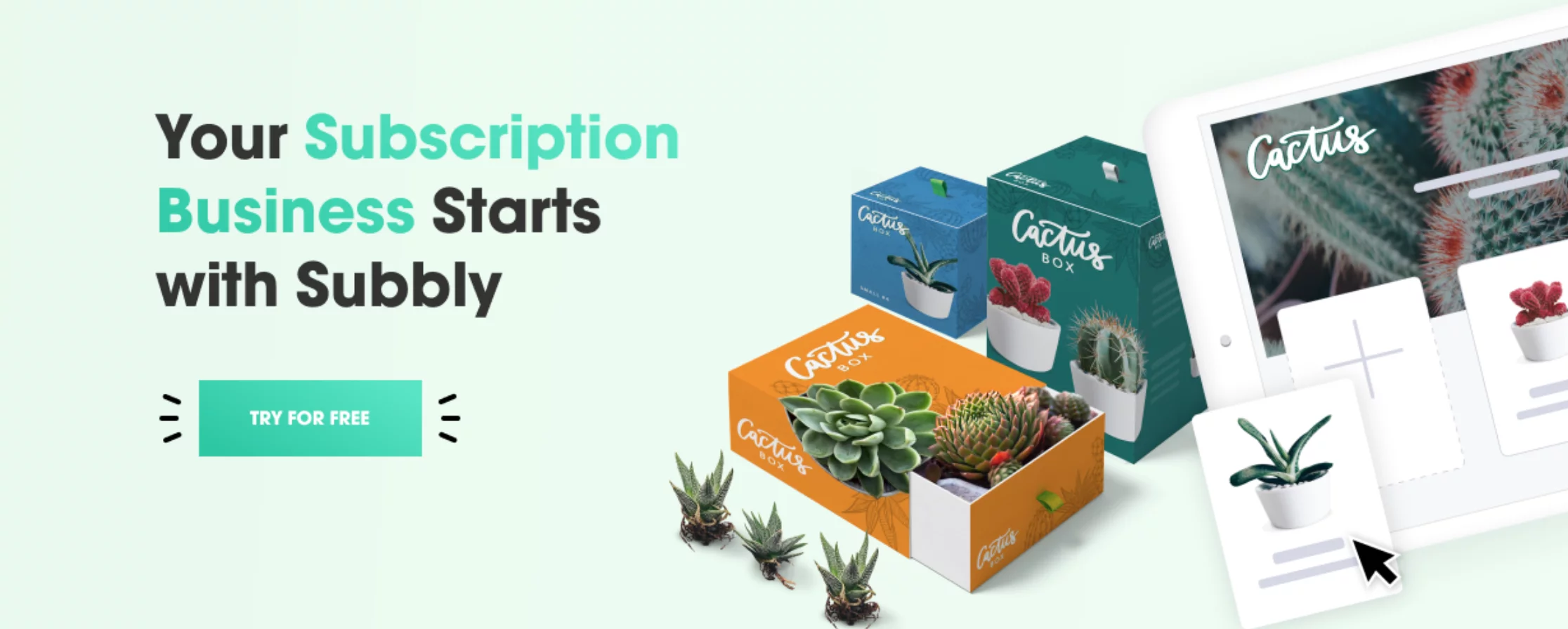
The subscription model in eCommerce is a goldmine for merchants. Not only does this approach help businesses scale, but it also allows them to bond with customers. And if you want to hear numbers speak, the subscription ecommerce market will grow by $478 billion in 2025.
Blue Apron, MeUndis, and Stitch Fix jumped on the bandwagon of the eCommerce subscription model. And they experienced benefits like growing recurring revenues and an increased base of loyal clients. So, if you’re thinking about following in their footsteps, we say do it. Read on to discover the advantages and examples of the ecommerce subscription model and get inspired by the companies who are already using it.
What is the ecommerce subscription model?

As you probably know, the eCommerce subscription business model implies that you provide goods or services to your subscribed clients on a regular basis. This model comes in three types:
- Repeat purchases: when the purchases of commodity items (razors, diapers, etc.) are automated for consumers
- Access models: when subscribers pay a monthly fee to receive goods at lower prices or monthly members-only perks
- Subscription boxes: when customers get special offers and personalized experiences in beauty, food, hobby, and apparel categories
Regardless of the type you choose, you’re sure to experience all the benefits of the subscription model.
Benefits of the subscription model in ecommerce for merchants

Growing a loyal customer base is just one of the benefits merchants get out of enhancing their business with a subscription option. We’ve found more of them.
Easier financial forecasting
The number one value subscriptions bring to your eCommerce business is the accurate prediction of earnings from recurring sales. With the subscription model, you can forecast financial fluctuations and analyze their consequences, both negative and positive. And while you’re analyzing your subscription performance, consider metrics like customer acquisition cost (CAC), churn rate, and monthly recurring revenue (MRR).
Improved inventory management
In the traditional eCommerce model, it’s hard to determine how many resources your business will need and how to minimize your waste to get even more profit.
With the subscription model, this process is much easier since you know exactly how many subscribers you have and what revenue to expect. This way, you can predict the demand and supply more effectively, preventing risks and optimizing your business.
Higher customer retention and improved relations
Offering a subscription model for customers will increase your chances of keeping them coming. After all, who wouldn’t continue interacting with a company that offers attractive discounts, bonuses, and other perks?
The subscription model opens up ways to engage users across various channels, including emails, push notifications, and social media networks. Being this close to consumers allows you to form communities around your product or service and build stronger, more trusting relationships with them. Plus, with direct access to your customers, you can always reach out to them for feedback and alter your services accordingly.
So, if your goal is to understand your customer’s preferences and form a strong bond with them, you should try the subscription model. It is sure to make you stand out. On top of that, satisfied subscription clients are already loyal enough to try out your other goods or services.
Okay, we’ve discussed the advantages the subscription model brings to your business. But what about the users? How can your customers benefit from it?
The key advantages of the ecommerce subscription model for customers

When you’re offering something new to people, you should always think about what’s in it for them – because that’s the first thing they’ll be thinking. Here are the benefits your customers will enjoy with a subscription model:
Convenience in purchasing
With subscriptions, customers can buy their favorite products or services hassle-free and without reordering them every month or week. Also, the subscription model has a flat rate that helps customers plan their budget. And don’t even get us started on the awesome feeling when in the middle of the daily chaos you’re receiving a lovely package you completely forgot about.
Receiving personalized experiences
It’s hard to overestimate personalization when it comes to shopping online. When you see that a business truly takes an individual approach when creating your experience, it makes you like it even more. This, of course, can’t be achieved without customer analysis and feedback, but investing in studying your users will always pay off.
Providing personalized experiences for customers is beneficial for merchants as well. They can discover what customers want and create services or products tailored to their client’s needs and expectations.
Discovering new products and services
With subscriptions, customers stay in the loop about the new products or services you’re offering and are the first ones to try out new arrivals. As an eCommerce merchant, you sell various goods that can be grouped according to themes. Each month, you can send out theme-based subscription boxes arranged from the goods you sell. This is definitely a win for your business in terms of profits and familiarizing your customers with the range of products you’re offering.
Now that you have these benefits laid out, you can go ahead and use them in your marketing campaigns. When your customers see the value they’ll receive from your subscription right away, they’re more eager to subscribe. And there are many eCommerce businesses that are already using this approach successfully.
Examples of ecommerce companies that use the subscription model
Amazon, eBay, Zalando, and other world-leading eCommerce giants implement a subscription model to attract, retain, and engage their customers. And they found it effective for business growth since the subscription model lowers spendings on retention and increases the engagement rate.
If you’re searching for inspiration, have a look at these examples of successful eCommerce companies that scaled their businesses thanks to the subscription model:
Birchbox

Birchbox has a smart yet fun way of selling cosmetics using the subscription model. Once customers sign up and pay for a subscription, they receive 4-5 samples of new products. Birchbox packs them nicely in a box that resembles a birthday present. This approach helps the company keep its customers and grow annual revenue with subscriptions.
Manscaped

Manscaped, a business that offers grooming products for men, has scaled its business with a subscription model as well. The company delights its customers with presents every 12 weeks. As Ben Ascott, a VP of Growth at Manscaped, said, the company increases its annual revenue every year thanks to this tactic.
Huel

Huel also found its way to use subscriptions to grow business. This nutrition company from the UK allows subscribers to choose how many products they want to buy and when those should be delivered.
Freshly Picked

Freshly Picked uses the subscription model to retain and please customers. This company offers 20% off its products for mothers and daughters, $10 monthly store credit, and free shipping with subscriptions.
Friction Free Shaving

Friction Free Shaving is a razor shaving service from the UK. This company uses subscriptions to keep and engage customers by offering them replacement blades and a new razor for free.
Convinced already? Then your next step will be implementing the subscription model at your business.
How to Implement the eCommerce Subscription Model

Of course, adding the subscription model to your business and running it requires some effort, but there’s nothing you can’t handle. Just follow these tips:
- Define your membership model. You should start with the subscription strategy. It must include pricing, what services you want to promote, and what results you want to achieve by launching the subscription campaign.
- Communicate your product value clearly. You should be honest and transparent about the value your products or services bring. Once you do, it will be much easier to acquire new subscribers and retain the existing ones.
- Define your positioning. With your product value in place, the next step will be to develop strong brand positioning in the eCommerce market. Having a subscription option will definitely make you stand out and is sure to increase your brand awareness.
- Really get to know your audience. The more you know about your subscribers, the more you can upsell and cross-sell to them. Personalized experiences like discounts and gifts will help you keep customers coming and build stronger relationships with them.
- Manage your subscription business. You’ll need to handle many routine things when managing a subscription business. Plus, you’ll have to gather and analyze numerous metrics to see the profitability and define your future steps. Software like Subbly can help you manage all that.
We genuinely believe that enhancing your existing business with a subscription option is a decision you won’t regret. We know this because Subbly is working with thousands of subscription merchants who love what they do.
Grow your business with the ecommerce subscription model!

In the increasingly competitive eCommerce market, the subscription model is what will differentiate you from the rest. Implementing it will help you increase revenue, create stronger relationships with customers, improve inventory management, and make accurate predictions about your business.
If starting a subscription business sounds overwhelming to you, Subbly can help you set it up and manage it as you grow. Just try our free 14-day trial and start using your subscription potential to the fullest!
Subbly – the purpose built platform for starting and growing subscription businesses
